Shallow Water Treasures
Wakatobi is famous for the diversity of its marine life. But you don’t have to be a diver to experience this rich menagerie of sea creatures. The extensive shallows that surround the resort provide snorkelers with unprecedented access to a wide variety of intriguing critters. Here are ten that you are likely to see.

Green turtles have been called the lawnmowers of the ocean because they nosh on the upper blades of seagrass without disturbing the roots. Photo by Walt Stearns
Green Turtles
You are almost guaranteed to see these hard-shell reptiles gliding through the water and hanging out in the reef shallows around Wakatobi. They also spend a lot of time grazing in the seagrass. Green turtles have been called the lawnmowers of the ocean because they nosh on the upper blades of seagrass without disturbing the roots. This grazing actually improves the health and growth of the seagrass beds. You can often get close to a turtle by finning slowly and in a parallel direction to their movement rather than moving right at them fast.
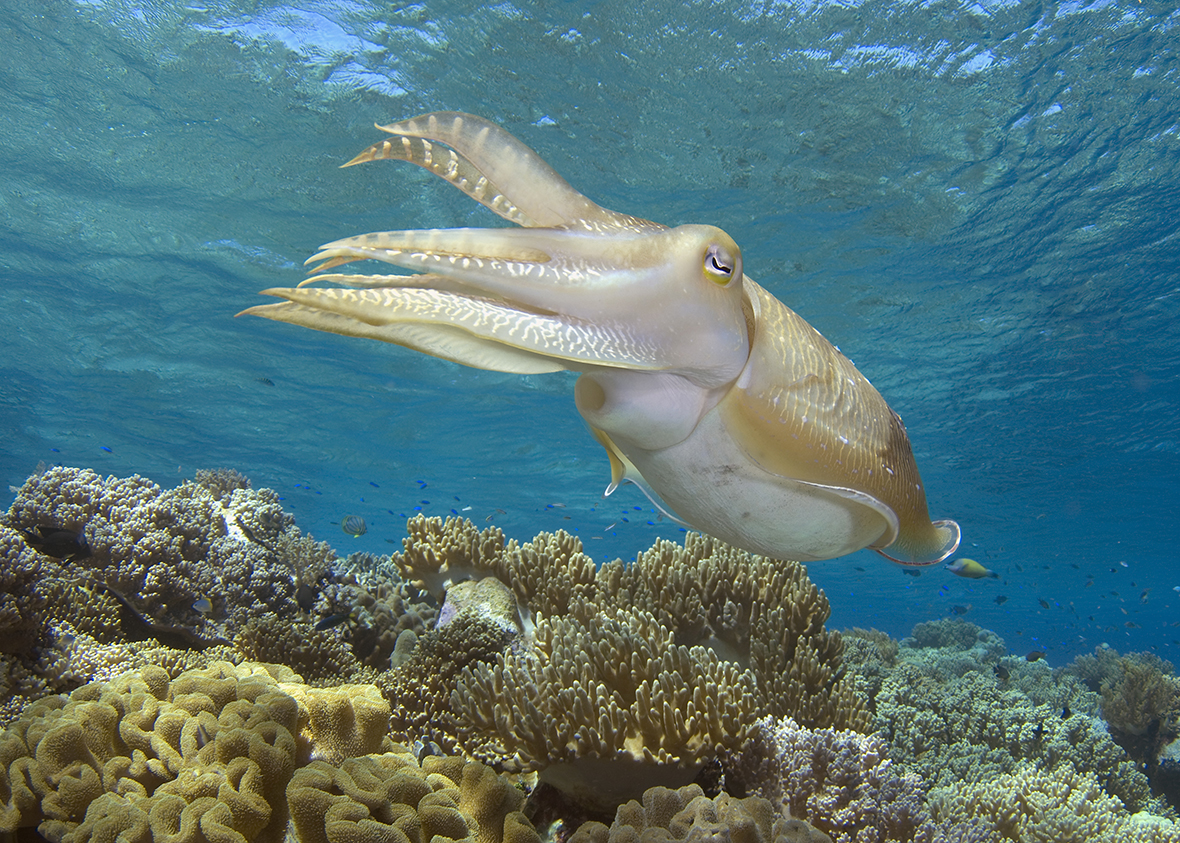
Broadclub cuttlefish are known to put on one of the most dazzling performances in the ocean, changing colors and skin patterns at a moment’s notice. Photo by Mark Snyder
Broadclub Cuttlefish
These chameleons of the reef are true masters of camouflage, able to mimic their surroundings so perfectly that they become almost invisible. But when they are not hiding from predators or hunting unsuspecting victims, the Broadclub cuttlefish can also put on one of the most dazzling performances in the ocean. Cuttlefish skin contains special organs and cells that reflect or refract light and can change colors and skin patterns at a moment’s notice. They use this ability to generate intricate flashing displays that serve as communication and warning or are used to create a hypnotic effect on prey.
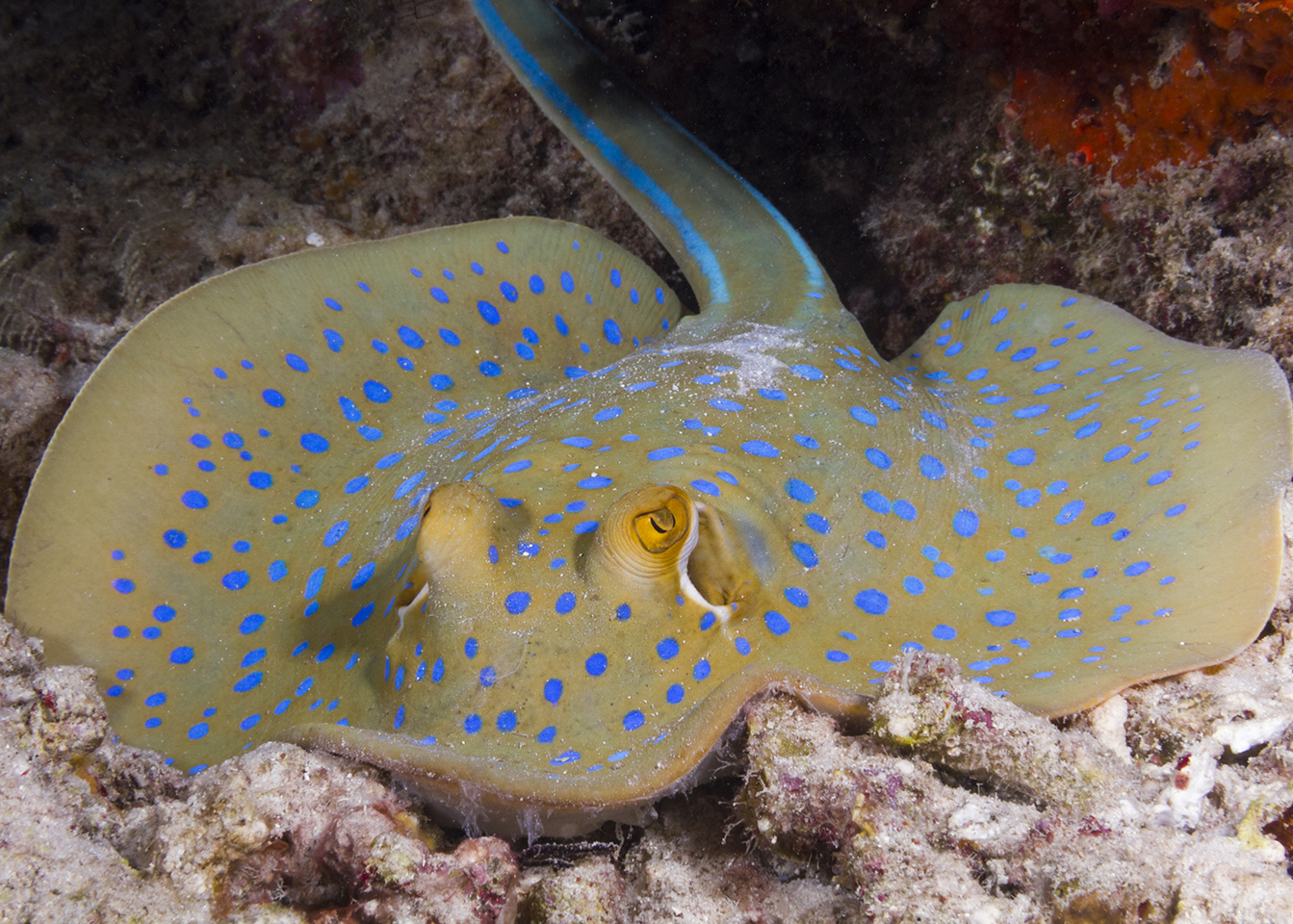
Blue-spotted ribbontail rays hunt in the shallows using electroreception to identify subtle temperature differences and electrical fields created by potential prey such as shrimp and crabs. Photo by Wakatobi Dive Resort
Blue-spotted Ribbontail Stingrays
This is one ray that is easy to spot, as they rarely bury themselves in the sand, and instead of blending in, they display a distinctive pattern of blue spots across their body. The markings serve as a warning to would-be predators because these rays are armed with a sharp serrated barb midway down their tail that also administers a strong dose of venom. Watch from a respectful distance and you’ll be fine, as the stinger is used only for defensive purposes. Blue-spotted ribbontail rays are most often found in shallow water over sand beds, where they hunt using electroreception to identify subtle temperature differences and electrical fields created by potential prey such as shrimp and crabs.
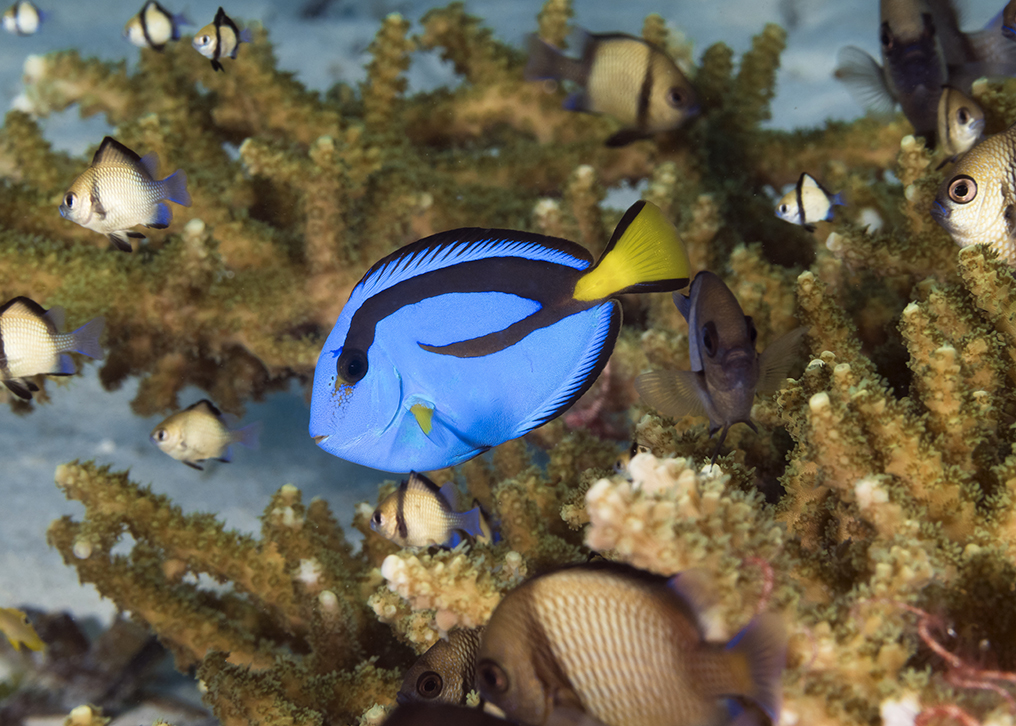
This real-life version of Dory is also known as the regal blue tang. They have the ability to change color from a light blue to a dark purple, creating a visual warning when necessary. Photo by Walt Stearns
Palette Surgeonfish
You won’t need a fish ID guide to identifying a palette surgeonfish —just look for Dory. This real-life version of the forgetful character from the movie Finding Nemo is also known as a regal blue tang. You may find one to even a group of these super colorful characters nibbling at a coral branch, though it’s actually feeding on algae that could otherwise cover the coral. If you get too close and startle one of these fish, you may see it turn from a light blue to a dark purple—creating a visual warning to others of its kind —then it will dart into a stand of coral and wedge itself among the branches. Any predator that goes after a palette surgeonfish that has cloistered itself in the coral may get a sharp surprise, as these fish sport a row of sharp and mildly venomous spikes along their back.
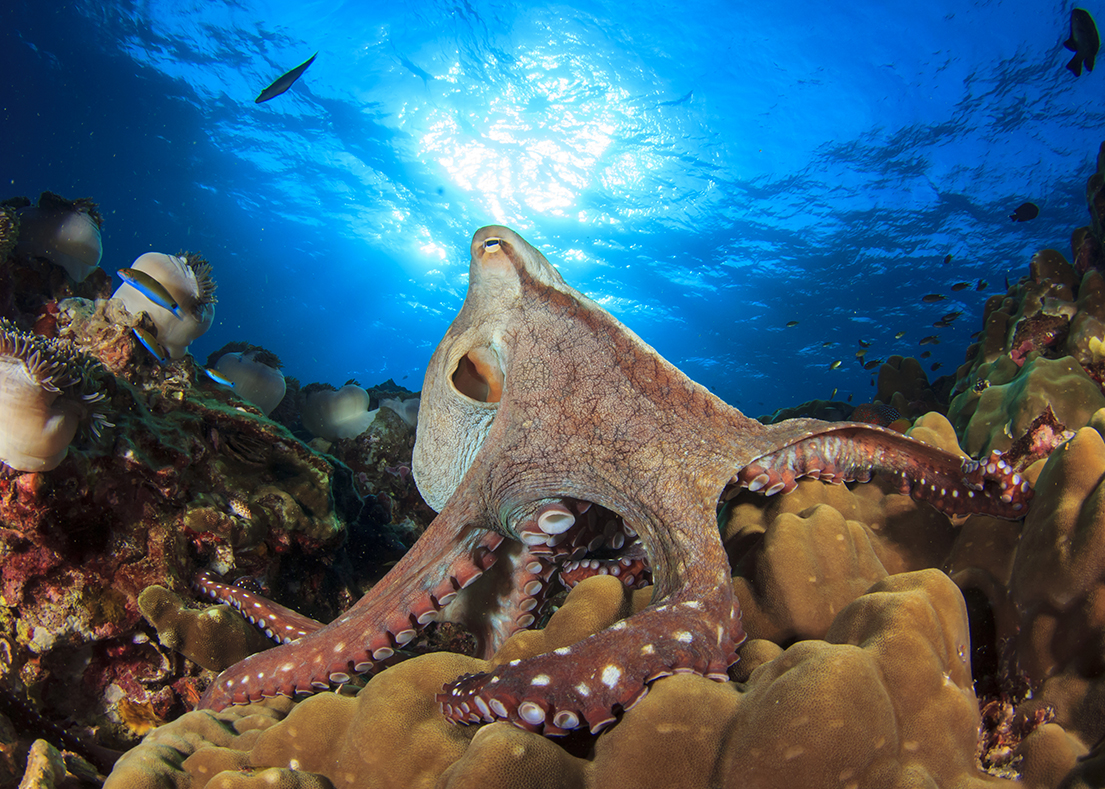
As the name implies, this canny cephalopod is active during daylight hours instead of working the night shift like many of its relatives. Photo by Rich Carey
Day Octopus
The day octopus is one of the larger members of the Octopodidae family, but it would be easy to snorkel right past on without noticing its presence. These shapeshifters have an almost uncanny ability to blend into their surroundings, altering not only their coloration but also the texture of their skin. As the name implies, this canny cephalopod is active during daylight hours instead of working the night shift like many of its relatives. If you are keen-eyed enough to spot a day octopus out and about, hang around for a while and watch as it slithers and flows through coral heads and rubble in search of crabs, clams, and small fishes.

It’s likely you’ll find more than one clownfish living in an anemone. A closer look may reveal that one fish is larger — that’s the dominant female. Photo by Walt Stearns
Clownfish
If you like clownfish, you are in luck. There are eight different species of these colorful little anemone dwellers that can be found on the House Reef in shallow water. As you approach a host anemone, you may be greeted by a clownfish that darts out with a threat display. These little fish are highly territorial, and not afraid to confront something as large as a snorkeler with a message to “back off.” It’s not uncommon to find more than one clownfish living among the anemone’s tentacles. Take a closer look and you’ll likely find that one fish is larger — that’s the dominant female. Her roommates will be male –one is the breeding partner, any others will be smaller non-breeders. Since these fish can switch genders in short order, this domestic situation can change with the loss of a family member.
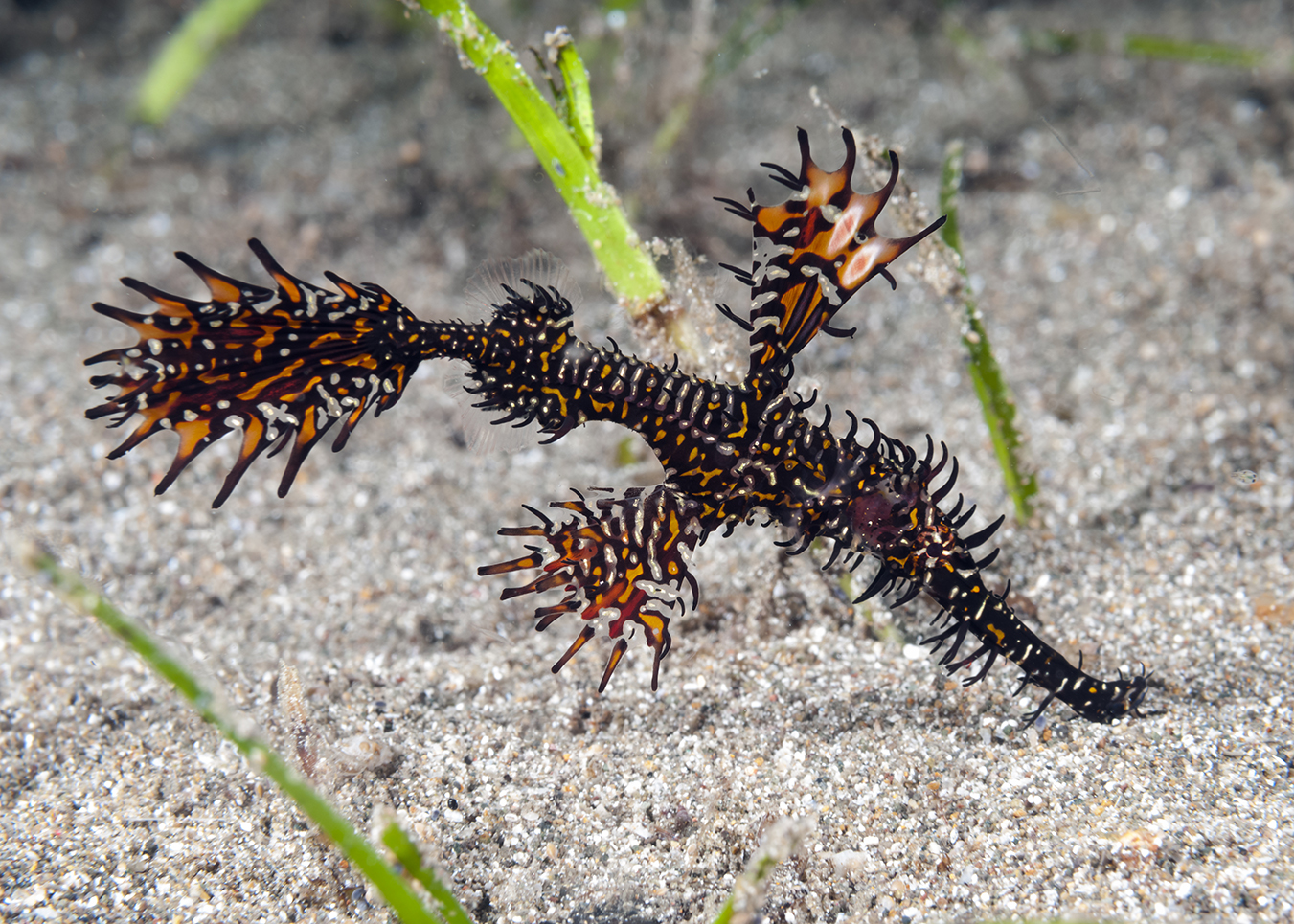
Like other pipefish and seahorses, ornate ghosts are rather passive carnivores, waiting patiently until a small shrimp or other bits of zooplankton come within range of their vacuum-like snout. Photo by Walt Stearns
Ornate Ghost Pipefish
Locating one of these intricately decorated little creatures can be a true ghost hunt. Your best chance of success is to take your time examining a grove of soft corals, gorgonians, or crinoids to find something out of place. At first glance, what might appear as a broken-off branch or limb may turn out to be an ornate ghost hovering face-down, its coloration and texture an almost perfect match for the surroundings. Like other pipefish and seahorses, ornate ghosts are rather passive carnivores, waiting patiently until a small shrimp or other bits of zooplankton come within range of their vacuum-like snout. If you happen to have a camera along, grabbing a portrait of this hunter in hiding will earn you some bragging rights, as this species is highly sought after by underwater photographers.
Banded Sea Krait
Despite their reputation as one of the most lethally venomous creatures in the sea, banded sea kraits do not pose a danger to snorkelers — unless you make a point of grabbing hold of one. Sea kraits are not aggressive and are more apt to retreat into a crevice or the safety of coral branches when threatened. If you spot a long, skinny creature with distinctive white and black bands, check its tail. Sea kraits have flattened tails that act like paddles to help them move through the water. If the tail tapers symmetrically, you’ve found an imposter — the banded snake eel — which is mimicking its venomous counterpart to fool predators. Sea Kraits are not true sea snakes, because they return to land to rest, digest and mate. When they are in the water and hunting, it can be fascinating to watch them weave their way through the coral branches in search of dinner.
Smooth Shrimpfish
When exploring one of Wakatobi’s seagrass beds and you happen on what appears to be a collection of yellow and silver leaves floating vertically just above the sea floor, take a closer look. You might be looking at a school of smooth shrimpfish on the hunt. These elongated and flattened shallow water dwellers are second cousins to a seahorse. They feed on tiny planktonic crustaceans and often hold themselves in a head-down position, waiting to slurp up any tiny morsel that comes within range. Startle them, however, and they will quickly transition to the horizontal and dart off to safety.
Mantis Shrimp
If it was the size of a car, a mantis shrimp would make the ultimate movie monster. These armored predators have trinocular, multi-spectrum eyesight — the most complex of any known animal. They sport spearing spikes or hammering claws that can be deployed in a matter of milliseconds to impale a victim with the speed of a bullet or strike with enough force to break through shells. Mantis shrimp spend most of their time lurking among rocks and burrowing in the seabed. There two species you are most likely to come across in the shallows of Wakatobi, Lisa’s Spearing Mantis Shrimp and the Peacock Mantis. If you happen across one out on the hunt, look but don’t touch or you might find out the hard way why these shrimps have earned the nickname “thumb splitters.”
These are just a few of the many fascinating creatures you can discover while snorkeling the shallows of Wakatobi. Small wonder that many of our guests enjoy their time in the shallows with mask and fins every bit as much as their time on scuba. And between the House Reef and dozens of dive sites equally suited for snorkeling, there’s a lifetime of discoveries awaiting near the surface.
Ready to plan your visit to Wakatobi? We encourage you to reach out to us, especially to plan for next year as we roll a lot of bookings ahead. Enquire at wakatobi.com.
Visit us on Facebook and Instagram
Great Wakatobi videos here.


